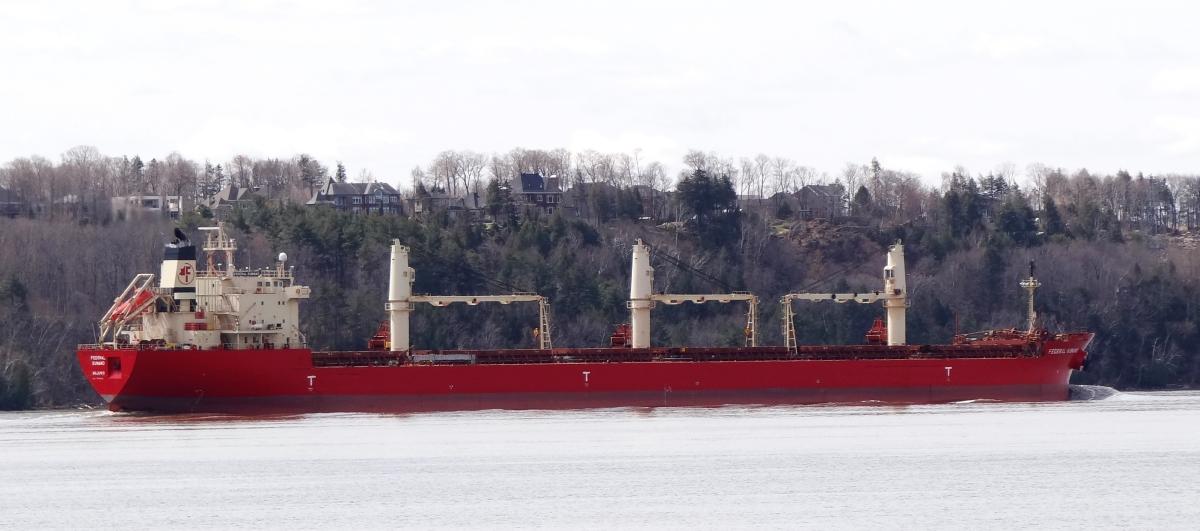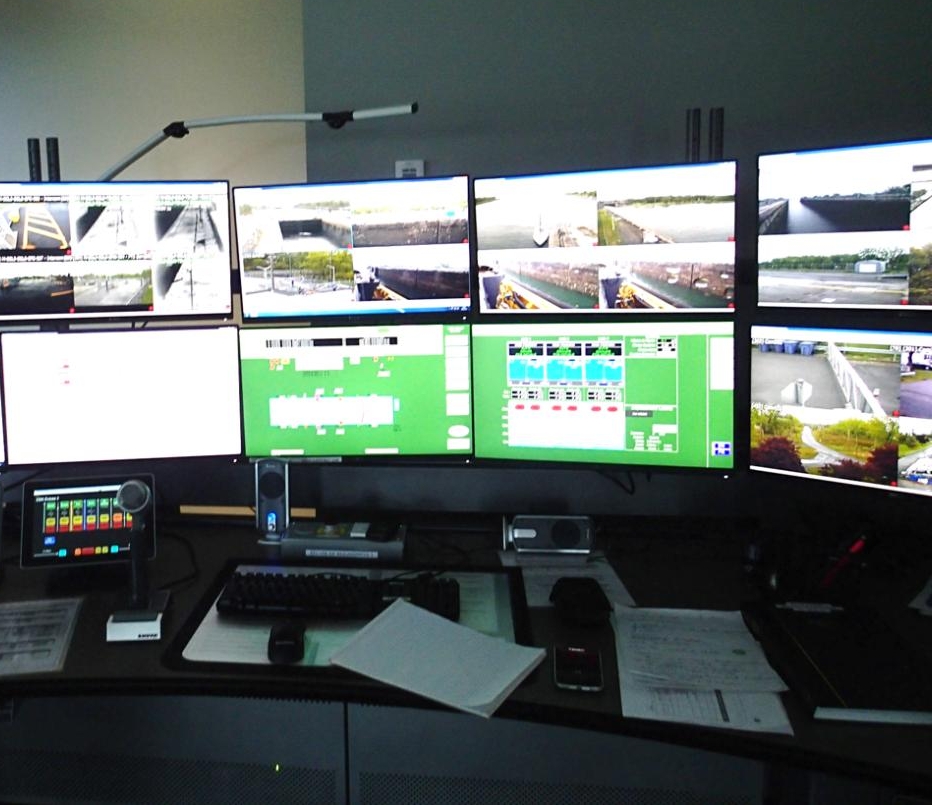Inadvertent lowering of ship arrester and closing of lock gates on vessel
Bulk carrier Federal Kumano
Beauharnois, Quebec
The Transportation Safety Board of Canada (TSB) investigated this occurrence for the purpose of advancing transportation safety. It is not the function of the Board to assign fault or determine civil or criminal liability. This report is not created for use in the context of legal, disciplinary or other proceedings. See Ownership and use of content. Masculine pronouns and position titles may be used to signify all genders to comply with the Canadian Transportation Accident Investigation and Safety Board Act (S.C. 1989, c. 3).
History of the voyage
On 11 May 2017, the Federal Kumano, a bulk carrier registered in the Marshall Islands (International Maritime Organization No. 9244257), departed Duluth, Minnesota, U.S., loaded with 23 100 tonnes of wheat (Figure 1). The vessel was scheduled to transit the Great Lakes and the St. Lawrence Seaway en route to Algeria.
Around 0800Footnote 1 on 17 May, the vessel was exiting the Lower Beauharnois lock in the St. Lawrence Seaway under the conduct of a pilotFootnote 2 (Figure 2). This lock is 1 of 13 that form part of the Canadian section of the St. Lawrence Seaway facilities and that are managed by The St. Lawrence Seaway Management Corporation (SLSMC).Footnote 3 The lock operator is located in a remote control station in Saint-Lambert, Quebec.
While the Federal Kumano was transiting the Lower Beauharnois lock, another vessel was in the Upper Beauharnois lock. The controls of the Upper Beauharnois lock were operated by an on-site operator located in Beauharnois. SLSMC procedures require that lock operators oversee a vessel at all times while it is in the lock and when it is entering and exiting, and that an operator manage 1 vessel at a time at 1 lock.
At approximately 0801, while the Federal Kumano was exiting the lock at a speed of approximately 0.5 knots, the operator of the Lower Beauharnois lock requested to be relieved for a break. At the time, the SLSMC did not have a formal handover procedure in place for breaks taken during a shift. The lock operator informed the relief operatorFootnote 4 that the vessel was exiting the Lower Beauharnois lock and that another vessel was in the Upper Beauharnois lock. The lock operator then left for his break.Footnote 5 The relief operator was 1 of 2 operators on duty at the time who were fully qualified. Vessel traffic was high, with approximately 12 vessels in transit in the sector.
The relief operator assumed lock operations and, shortly afterward, received a telephone call from the on-site operator of the Upper Beauharnois lock, who said that he had just released the water into the basin. The relief operator became concerned that the basin level would increase excessively and wanted to close the lock's lower gates as soon as possible after the Federal Kumano had exited in order to prevent the released water from spilling over the basin's dam. The relief operator shifted his attention to regulating the water levels and, at about 0805, closed the lock's lower gates and ship arrester. At this time, the Federal Kumano was still manoeuvring to exit the Lower Beauharnois lock.
As the ship arrester was closing, it struck the jib wires of the vessel's No. 1 deck crane. At the same time, the lock gates also closed and made contact with the vessel's sides.Footnote 6 At the time, Federal Kumano crew members were on deck near the No. 1 deck crane, but no injuries were reported.
The pilot stopped the vessel and advised the relief operator of the situation by very high frequency radiotelephone. At 0811, the relief operator reopened the ship arrester and the lock gates. After the vessel was repositioned in the lock, a preliminary inspection was conducted. Following this inspection, the vessel continued eastbound to section 50 in the Port of Montreal, where it underwent a more detailed inspection. Following the incident, an inspection of the lock showed that the ship arrester had sustained minor damage.
Remote operational control centre and workstations
In March 2017, the SLSMC moved lock operations to a new centralized operating control centre in Saint-Lambert, Quebec. On 20 March, lock operators who had previously operated the locks from an on-site location began operating locks remotely from the control centre. Implementing a remote operation involves concurrent changes to several aspects of operations (including staffing levels, process displays, and communication protocols).
The workstation camera layout in the remote control centre is similar to that of the workstations at the locks. Each workstation has a number of closed-circuit television cameras and applications to allow lock operators to view all equipment (Figure 3). These control stations include screens displaying video feeds of the lock or canal structure, perimeter security cameras, the traffic management system, the automatic identification system, vessel traffic, and the hands-free mooring system.
As part of the infrastructure expansion and automation program for the remote control centre's functions, the SLSMC developed a transition plan, which included an operational risk assessment by an external firm in 2016. The operational risk assessment made a number of recommendations for technical solutions to mitigate risks to vessel and non-vessel traffic as an additional safety defence against operational error.
For example, the risk assessment recommended having perimeter motion detectors, vessel detectors, and detector beams in line with ship arresters and alarms on the console. It also recommended enhanced supervision to help identify high workload: the supervisor could reduce the number of tasks performed by an operator by assigning an additional operator. The operational risk assessment provided several training recommendations, including providing training in team communication and situational awareness. Some of the recommendations were identified as compulsory and were ordered by priority level.
At the time of the occurrence, the SLSMC had implemented all of the compulsory recommendations according to the order of priority set out by the risk assessment. Some of the non-compulsory recommendations had not been implemented. The SLSMC periodically reassessed various risks but did not systematically reassess these recommendations to determine the effectiveness of the measures taken.
The TSB investigation into this occurrence identified areas of concern similar to those identified by the operational risk assessment, specifically with respect to training, workload, supervision, and shift handovers.
Training
Compared to local operation, remote operation places more importance on the skill and ability of operators. Operators are better prepared if they have training in similar settings, such as scenario-based training, so that they can rapidly process a situation, make judgments, and decide on an appropriate course of action.
The SLSMC lock operator training program is 2 years long and consists of operations controller and maritime radio training. At the time of the occurrence, the relief operator had all of the required qualifications, which included 120 hours of training on the remote operation of the Beauharnois locks. He had accumulated nearly 30 years of experience as a lockmaster and had previously worked at the Côte-Sainte-Catherine lock. Prior to the occurrence, the new remote control centre had been in operation for 2 months and the relief operator had been remotely operating the Beauharnois locks for 5 weeks. In March 2017, the lock operators had received a special 1-day training session on remote control with specific emphasis on camera operations.
Workload
Lock operators work in a complex environment where there are multiple sources and types of information to monitor and prioritize. At the same time, human attention and the capacity to process information are limited. Workload is a function of the number of tasks that must be completed within a given amount of time. If the number of tasks that must be completed increases, or if time available decreases, workload increases. High levels of workload can adversely affect an operator's ability to perceive and evaluate cues from the environment and may result in attentional narrowing. Persons operating under conditions of high workload can become task-saturated or overloaded and may channel their attention, concentrating on some tasks at the expense of others.
Handover procedure for breaks
Without a structured handover, the likelihood that critical information will be missed and misunderstandings occur is increased. Both lock operators involved in a handover have a responsibility to effectively communicate the current situational status. A lock operator's situational awarenessFootnote 7 is particularly at risk during handovers. The loss of situational awareness can rapidly lead to inaccurate assumptions, less-than-optimal decisions, and errors. At the time of the occurrence, the SLSMC did not have a formal procedure in place for handovers for breaks taken during a shift.
Safety messages
This occurrence highlights the importance of
- systematically reassessing measures taken to mitigate risks in order to determine their effectiveness and to identify any unresolved issues that may affect the safety of operations; and
- structured procedures for handovers between operators to help ensure that critical information is shared.
Safety action taken
The St. Lawrence Seaway Management Corporation implemented the following safety actions:
- On 09 June 2017, it introduced a handover checklist that included practices and procedures for all handovers of lock controls. All operations staff received training on handovers and the conditions that need to be met.
- In early 2018, it redistributed the lock operators' tasks and identified 1 operator per shift for surveillance and access control.
- A traffic management system (TMS) display was added to each lock operator's console to provide the position of all vessels in the vicinity of the lock structures.
- An enhanced vessel display within the TMS has been deployed at all high-lift locks.
- For the Montréal / Lake Ontario region only, an alarm has been added to the TMS graphic screen that is triggered when a vessel is approaching a lock, which increases the lock operators' spatial awareness.
This concludes the TSB's limited-scope investigation into this occurrence. The Board authorized the release of this investigation report on . It was officially released on .


